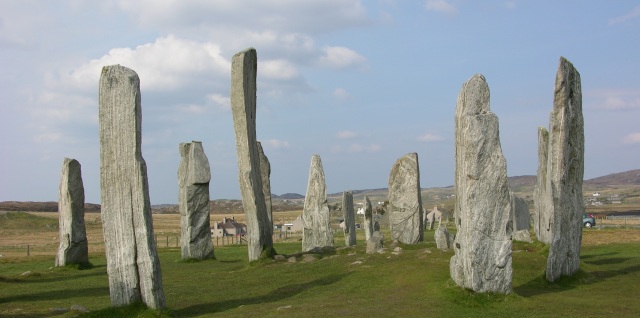 On Friday 30th October 1863, four young people from the town of Stornoway, Isle of Lewis, set off on a short holiday to Callanish, famous – then as now – for its standing stones. They were two unmarried couples: Charles Morrison and Christina Gerrie; Donald McRae and Isabella (Isy) Nicolson. Charles – who recorded the visit in his diary – was a shopkeeper and Donald a baker.
On Friday 30th October 1863, four young people from the town of Stornoway, Isle of Lewis, set off on a short holiday to Callanish, famous – then as now – for its standing stones. They were two unmarried couples: Charles Morrison and Christina Gerrie; Donald McRae and Isabella (Isy) Nicolson. Charles – who recorded the visit in his diary – was a shopkeeper and Donald a baker.
Charles hired a ‘conveyance’ – presumably a horse and cart – from Mrs J. Clark. This was undoubtedly Jessie Clark, wife of the auctioneer Thomas Clark of the Esplanade Hotel (close to Charles’s shop on North Beach Street) who advertised transport to Callanish in various Highland newspapers. Jessie, like one of the grooms in her employ, came from Callanish. The party left Stornoway at 5.30pm, at the end of the day’s business, arriving at Callanish at 8.30pm. Nowadays this journey takes 30 minutes by car.
It’s uncertain where Charles and his friends lodged. The most likely place was Callanish Inn, located close to the shore. Now enlarged and known as Callanish Farmhouse, this building stands in front of the modern Visitor Centre and is available as holiday accommodation. In the 1860s, as a single-storey farmhouse built of stone with a slate roof, it was clearly superior to the local crofters’ thatched blackhouses. Its triangular garden survives, filled with windblown shrubs.

Callanish Farmhouse
Isy Nicolson’s father, John Nicolson, resided in Callanish. According to the 1861 Census he was a crofter at 29 Callanish. By 1864 he had become the tacksman or farmer of Callanish and probably lived at the Inn, which also served as the farmhouse. Indeed, the Inn may well have been 29 Callanish; today, number 28 lies nearby. If this is right, Charles’s party would have been staying with Isy’s father, perhaps explaining the absence of a chaperon.
Charles and Donald inspected the ‘Druidical Stones’ (Tursachan) in the rain the following morning. The weather had improved by mid-day and – with Christina – they took a boat to Linshader. This ferry (Aiseag Linshader) had been owned and operated by the proprietor of the Callanish Inn for some time; in fact, the Norse name ‘Callanish’ is thought to refer to a ferry crossing. The rudimentary slipway was located next to the Inn and, around 1850, the charge for the crossing was one shilling per person. Linshader village (at that time, more correctly, a farm) stands opposite Callanish at the mouth of Loch Ceann Thulabhaig. Leaving Donald in Linshader, no doubt visiting friends or family, Christina and Charles walked back via Grimersta (well known for its fishing lodge) and Garynahine, which Charles calculated as 7 miles.

The remains of the slipway of the Linshader ferry, close to Callanish Farmhouse
On Sunday Charles’s party attended a lengthy Presbyterian service two miles north of Callanish, in the Schoolhouse at Breasclete. The Callanish teacher, Angus Matheson, read from Acts, commenting as he went along. They were uncomfortably seated in the close and crowded room from 11.45am until 3.30pm. Afterwards they socialised with Alexander Macrae of ‘Melstay’ (Mealista?), and Miss Macrae of Linshader.

Callanish: Chambered Tomb and Stone Circle
Charles and Donald visited the stones again on the Monday morning: Charles counted 47 monoliths. The peat that covered the site had been cleared away as recently as 1857, by order of Sir James Matheson, revealing the true height of the stones and also uncovering a chambered tomb within the central circle. After studying the stones, Charles and Donald walked to the mill at Breasclete and, at 5pm, went to Linshader (no doubt by boat) for their tea. They spent the evening singing and dancing, and left at 10pm.
On Tuesday it rained again: Charles and Christina kept to the house. They were visited in the evening by Alexander Mackenzie from Newton (in the town of Stornoway; perhaps he was staying at the Inn) and Miss Macrae. Once again the night was spent singing and dancing.
Charles rose early on Wednesday, 4th November, and went to nearby Garynahine, presumably on foot, to see if he could hire a conveyance to take them back to town, but he was unlucky. There seems to have been no public transport whatsoever. Somehow, around 1pm the party received word that Christina’s mother, Mrs Gerrie, had broken her leg, making it imperative for Christina to return home. Leaving at 2pm Charles walked to Stornoway (17 miles), where he hired a conveyance (presumably a simple horse and cart) and drove back to Callanish, arriving at 1.30am. The following afternoon he took Donald and Christina back to town. It was the end of their jaunt, but it seems to have been a turning point – if only temporary – in Charles’ tense relationship with his disapproving future mother-in-law.
In September 1864 Charles Morrison married Christina Gerrie, and in November 1864 Donald Macrae married Isy Nicholson. Both couples continued to live in Stornoway.

Angus Matheson was my great-great grandfather. His headstone in Sandwick cemetery in Stornoway records that he was “teacher at Callanish for 38 years a faithful witness to the truth who died rejoicing in his [God]”.
LikeLike
Sounds like your ancestor had lots of stamina when it came to preaching! Imagine, a four hour sermon! Thanks for your comment – I’ll look out for his headstone.
LikeLike